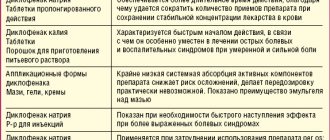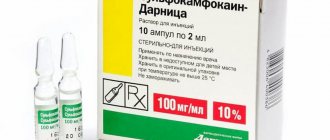Pharmacological properties of the drug Naklofen
Diclofenac ([o-(2,6 dichloroanilino)phenyl]acetate sodium salt) is an NSAID with pronounced anti-inflammatory, analgesic and antipyretic effects. The mechanism of action is associated with the inhibition of COX and the resulting disruption of prostaglandin synthesis. By blocking the synthesis of prostaglandins, diclofenac eliminates or significantly reduces the severity of symptoms of inflammation. Diclofenac reduces prostaglandin-induced increased sensitivity of nerve endings to mechanical stimuli and biologically active substances that are formed at the site of inflammation. Helps lower body temperature, preventing the effect of prostaglandins on the hypothalamic region of the thermoregulation process, reduces the concentration of prostaglandins in menstrual blood and the intensity of pain during primary dysmenorrhea. During treatment with diclofenac, the concentration of prostaglandins in the urine, gastric mucosa and synovial fluid decreases. During the treatment of rheumatoid arthritis, the drug intensively penetrates into the joint cavity, reduces pain at rest and during movement, helps to increase the range of motion in the affected joints, and reduces morning stiffness and swelling of the joints. Naklofen is used to treat rheumatic diseases; to eliminate pain of any localization of various origins. The tablets are coated with an acid-resistant coating and dissolve after entering the intestines. Naklofen Duo contains diclofenac in the form of granules that are resistant to the action of gastric juice and prolonged-release granules, as a result of which the capsules have both rapid and prolonged action. Retard tablets are intended for long-term treatment. After oral administration, diclofenac sodium is rapidly absorbed in the duodenum and small intestine. Over 90% of the drug is absorbed, but due to metabolism during the initial passage through the liver, bioavailability is about 60%. About 99% of diclofenac binds to plasma proteins, mainly albumin. The half-life is 1–2 hours. More than 70% of diclofenac is excreted in the urine in the form of biologically inactive metabolites, only 1% is excreted unchanged. Diclofenac easily penetrates into the synovial fluid, where its concentration reaches 60–70% of the level in the blood serum. After 3–6 hours, the concentration of the drug and its metabolites in the synovial fluid is higher than in the blood serum. Diclofenac is eliminated from synovial fluid much more slowly than from blood serum.
Release form
The medicine is produced in the form of brown-yellow round tablets. The shape is biconvex, smooth. Each tablet is coated with an enteric film coating. There are 2 packages in cardboard boxes, 10 tablets per package.
The drug is produced in the form of cone-shaped suppositories, white or white with a yellow tint. If you separate the candle, you can see a waxy white or yellowish mass inside. Rectal suppositories are in strips of 5 pieces, 2 strips in a cardboard box.
The solution for intramuscular administration is a clear, colorless or slightly yellowish liquid. The drug is produced in ampoules of 3 ml, 5 ampoules in a blister or plastic tray.
The product is also produced in the form of a white, homogeneous gel, for external use, in aluminum tubes of 60 grams.
Indications for use of the drug Naklofen
Diseases whose treatment requires anti-inflammatory and/or analgesic action:
- inflammatory rheumatic diseases: rheumatoid arthritis, seronegative spondyloarthritis, chronic juvenile arthritis, arthritis of various etiologies;
- degenerative rheumatism of the joints and spine: arthrosis, spondylosis;
- arthritis caused by metabolic disorders: gout and pseudogout;
- extra-articular manifestations of rheumatism: periarthritis, bursitis, myositis, tendonitis, synovitis;
- other lesions of the musculoskeletal system, accompanied by inflammation and pain;
- as an analgesic for primary and secondary dysmenorrhea, in the postpartum period, for renal and biliary colic, soft tissue injuries, in the postoperative period and after various dental procedures.
Use of the drug Naklofen
For adults with acute pain syndrome, Naklofen is prescribed 3 ml of solution intramuscularly (contents of 1 ampoule) 1–2 times a day for a short time, followed by switching to oral administration or rectal administration of the drug. For patients with pain syndrome due to renal colic, a second injection at a dose of 75 mg can be prescribed 30 minutes after the first. Parenteral administration of the drug to children is not recommended. The tablets are taken orally during or after meals without chewing, with a small amount of water. Adults are prescribed an initial dose of 100–150 mg/day, depending on the severity of the disease; the usual maintenance dose is 100 mg/day. Children over 14 years of age are prescribed a daily dose of 100 mg, which must be divided into 2 doses. If taking Naklofen tablets is combined with the use of other dosage forms, the total daily dose of the drug should be taken into account. The daily dose of diclofenac is 150 mg and depends on the severity of the disease. At the beginning of treatment, 1 capsule of Naklofen Duo is prescribed 1-2 times a day. In case of severe symptoms, especially in the morning, the daily dose (2 capsules) can be taken in one dose or after a short period of time. Maintenance dose - 1 capsule per day. If taking Naklofen Duo capsules is combined with its other pharmaceutical forms, the total daily dose of the drug should be taken into account, which should not exceed 150 mg. Capsules should be swallowed whole with a small amount of liquid during or immediately after meals. Retard tablets are prescribed 1 tablet per day. For patients who do not tolerate oral administration of the drug, it can be prescribed in suppository form. The initial dose is 100–150 mg/day, usually 1 rectal suppository of 50 mg 2–3 times a day. The usual maintenance dose is 1 suppository of 50 mg 2 times a day. Suppositories are not indicated for use in children.
Compound
One tablet contains 50 mg of diclofenac + corn starch, povidone, magnesium stearate, hypromellose, yellow iron oxide, methacrylic acid and ethyl acrylate copolymer, lactose monohydrate, microcrystalline cellulose, silicon dioxide, red iron oxide, titanium dioxide, talc, propylene glycol.
Contains suppositories (per suppository): 50 mg of diclofenac sodium + solid fat.
One ampoule of the product contains: 75 mg of diclofenac , benzyl alcohol, sodium disulfite, water, propylene glycol, sodium hydroxide.
Gel for external use contains (in one gram): diclofenac – 10 mg + additional substances (macrogol, isopropanol , anhydrous sodium sulfite, decyl oleate, liquid paraffin, carbomer, diethanolamine, propylene glycol, cetomacrogol).
Side effects of the drug Naklofen
Possible side effects from the gastrointestinal tract (nausea, abdominal pain, diarrhea, constipation, dyspepsia and flatulence), headache, dizziness, which, as a rule, do not require cessation of treatment. Very rarely possible: bleeding, ulcers and perforation of the gastrointestinal tract, asymptomatic hepatitis, jaundice, acute hepatitis, chronic active hepatitis, hepatocellular necrosis and cholestasis, skin rash, itching, peripheral edema (swelling of the extremities), depression, insomnia, fatigue, anxiety , irritability or drowsiness, renal failure, hematuria. In isolated cases, the development of nonspecific hemorrhagic colitis, relapse or worsening of ulcerative colitis or the appearance of Crohn's disease, hypersensitivity reactions (bronchospasm, angioedema, anaphylactic shock), photosensitivity, anemia, thrombocytopenia, leukopenia and agranulocytosis are observed.
Special instructions for the use of Naklofen
For patients with a history of gastrointestinal bleeding, diclofenac is prescribed only in urgent cases, under close medical supervision, with the simultaneous use of antiulcer drugs. Caution is also required when prescribing Naklofen to patients with ulcerative colitis and Crohn's disease, since diclofenac can cause a relapse or exacerbation of the disease. Diclofenac is prescribed with caution to patients with renal, hepatic or heart failure, patients with epilepsy, porphyria, impaired hemostasis, as well as patients who have been treated with anticoagulants or fibrinolytics. In elderly patients, diclofenac should be prescribed at the minimum effective dose. Although diclofenac has not been experimentally established to have teratogenic properties, the drug should not be prescribed during pregnancy unless the potential benefit to the mother outweighs the possible risk to the fetus. It is especially not recommended to prescribe the drug in the third trimester of pregnancy, since the blockade of prostaglandin synthesis caused by it can lead to premature closure of the ductus arteriosus. It is recommended to stop breastfeeding while taking the drug. The drug may slightly affect the patient’s ability to drive and operate machinery. Patients with dizziness and central nervous system disorders should refrain from driving vehicles and working with potentially dangerous mechanisms.
Contraindications
The medicine is contraindicated:
- if you are allergic to diclofenac or other NSAIDs ;
- in the last trimester of pregnancy ;
- for stomach and duodenal ulcers (for oral forms);
- for bronchial asthma ;
- in the presence of destructive and inflammatory bowel diseases (tablets and suppositories);
- period after coronary artery bypass surgery ;
- bleeding disorders;
- children under 6 years old.
Please be careful:
- with ischemic heart disease ;
- hyperlipidemia and dyslipidemia ;
- for diabetes mellitus ;
- in the 1st and 2nd trimester of pregnancy;
- smokers and frequent alcohol drinkers.
Drug interactions Naklofen
Simultaneous administration of Naklofen with lithium salts or digoxin may cause an increase in their concentration in the blood serum. Naklofen may reduce the diuretic effect of some diuretics; its simultaneous administration with potassium-sparing diuretics can lead to the development of hyperkalemia. When administered simultaneously with acetylsalicylic acid or other NSAIDs, the risk of side effects increases. May enhance the nephrotoxic effect of cyclosporine and the toxic effects of methotrexate, reduce the effectiveness of antihypertensive drugs. Diclofenac generally does not affect the activity of oral hypoglycemic agents.
Analogs
Level 4 ATC code matches:
Voltaren
Rapten
Zerodol
Dickloberl Retard
Dikloberl N 75
Dicloberl
Ketanov
Dolak
Panoxen
Ketorolac
Naklofen Duo
Olfen-100
Olfen-75
Neurodiclovit
Nizilat
Fanigan
Aertal
Methindol retard
Ortofen
The most common analogues: Diclak, Diclofenac, Voltaren, Rapten, Naklofen Duo, Almiral, Diclobrew, Dicloberl, Dicloreum, Olfen, Indomethacin , Fanigan Fast, Feloran, Fastum gel, Nise, Dolgit, Dolaren, Flamidez, Ketorol, Ketonal.

